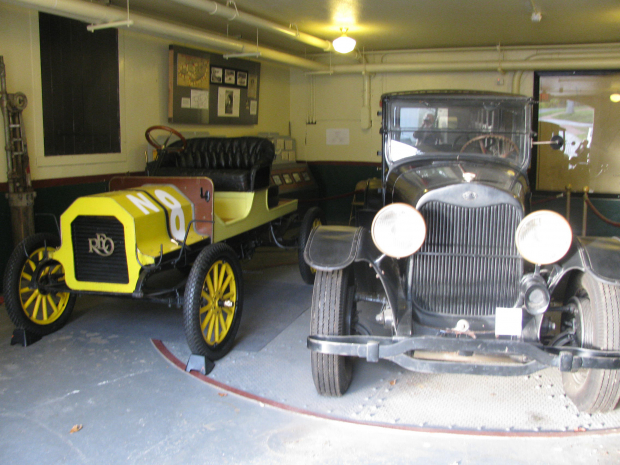Vanderbilt Museum Announces New Automobile Addition to Its Exhibit

The Suffolk County Vanderbilt Museum has issued the following press release:
A Restored 1909 Reo Gentleman’s Roadster Goes on Display for the First Time in Years at Vanderbilt Museum
Classic Automobile, Donated 51 Years Ago by Huntington Man, Enhances Exhibit on History of Vanderbilt Cup Races
A rare 1909 Reo Gentleman's Roadster, donated a half-century ago to the Suffolk County Vanderbilt Museum, is now partially restored and on exhibit once again in the Turntable Gallery of William K. Vanderbilt II's mansion, next to his 1928 Lincoln touring car.
Visitors, in addition to seeing both classic automobiles, can learn about the history of the famous Vanderbilt Cup Races, which Vanderbilt created in 1904. That same year, Vanderbilt, a pioneer American race driver, set a new land-speed record of 92.3 miles per hour in a Mercedes at a course in Daytona Beach, Florida.
The Turntable Gallery displays Vanderbilt Cup photographs and memorabilia and includes detailed dioramas that depict exciting moments from the races.
In October, the Reo was shown at a Cradle of Aviation museum exhibition in Garden City that commemorated the 100th anniversary of the 1910 Vanderbilt Cup competition. The exhibition, "The Incredible Vanderbilt Cup Races Held on the Long Island Motor Parkway (1908-1910)," was developed and presented by the author and historian Howard Kroplick, who created the website VanderbiltCupRaces.com.
Kroplick, a longtime friend of the Vanderbilt Museum, financed the recent restoration of the Reo, which was done by Long Island auto restorer Sam Greco, who owns a Reo. Owner Harry Gilbert of Huntington, New York, made a gift of the Reo to the Vanderbilt Museum in 1959.
The car, which has no permanent exhibition space at the museum, was displayed through the 1970s in the Vanderbilt's Education Center and in the 1980s in the mansion's Turntable Gallery. In the 1970s, the Reo was also exhibited at the Long Island Automotive Museum in Southampton, New York.
Before he created the Reo, Ransom Eli Olds ran the Olds Motor Works, where he manufactured Oldsmobiles. He left that company and founded a new one in Lansing, Michigan. Using his initials, he named the new enterprise the Reo Motor Car Co. The 1909 model cost $1,000 or $23,600 in today's dollars. The two-cylinder, 20-horsepower automobile—which had a noiseless chain drive, two speeds and reverse, and a 12-gallon gas tank—could reach top speeds of 40-45 miles per hour.
William K. Vanderbilt II's Legacy of Exploration and Education
The Vanderbilt Museum is celebrating it centennial year. The global explorer, adventurer and railroad heir William K. Vanderbilt II purchased 20 acres of land for his "Eagle's Nest" estate and mansion—now home to the Vanderbilt Museum—in May 1910.
That year, Willie K., as he was known to family and friends, hired a famous architect to design and build his summer home. "Eagle's Nest" eventually grew to 43 acres, becoming one of the grand, storied, Gold Coast estates. The Vanderbilt— built in three stages from 1910 until 1936—is a unique combination of historic estate and mansion, marine and natural-history museum, planetarium and park. The spectacular estate is listed on the National Register of Historic Places. The Vanderbilt Museum annually welcomes 100,000 visitors, who include 50,000 schoolchildren.
William K. Vanderbilt II circumnavigated the globe twice in the 1920s and 1930s in his ocean-going yacht, and brought back significant collections of natural-history specimens—birds, fish and invertebrates—as well as ethnographic artifacts from Africa and Asia. He pioneered auto racing in the United States, established the Vanderbilt Cup Races, and spurred the development of the American auto industry.
The popular, international Vanderbilt Cup Races drew drivers from around the world and were run on a famous course Vanderbilt established in Nassau County, Long Island. These exciting and dangerous events, the most prestigious automobile events of their day, attracted crowds of up to 250,000 people. From 1908 to 1910, the race courses included Vanderbilt's Long Island Motor Parkway, the first road built exclusively for automobiles and the prototype for the first toll road.
Details on the Suffolk County Vanderbilt Museum's new addition and exhibit were reported in today's issue of the Huntington Patch .
Links to related posts on VanderbiltCupRaces.com:
The 1909 Reo Gentleman’s Roadster from the Vanderbilt Museum
Seventh Annual Vanderbilt Race Centennial Celebration at the Cradle of the Aviation
Starting Lineup- The 8 “N” Cars of the 1908 Nassau Sweepstakes



Comments
Interesting as always - are there any more photos of the Lincoln. As it has non-factory fenders, It must be a one-off custom. Thanks again Hugh
Congratulations, Howard…on your generous assistance with the REO. Maybe one of these days, we will see you driving it too, if you can tear yourself away from La Bête Noire!
Thanks Hugh and Robert:
The fenders on the Lincoln were custom made out of leather to reduce the noise from stones and pebbles.
Howard